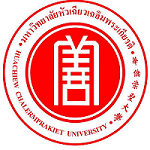Please use this identifier to cite or link to this item:
https://has.hcu.ac.th/jspui/handle/123456789/4832| Title: | Design, Synthesis and Molecular Docking Study of Novel Celecoxib Derivatives Using Bioisosteric Replacement of Sulfonamide Moiety |
| Authors: | Thanchanok Loog-in Kulpornsorn Isswanich Phuri Thanarangsarit ธันว์ชนก ลูกอินทร กุลพรสรณ์ อิสสวาณิชย์ ภูริต ธนะรังสฤษฏ์ Huachiew Chalermprakiet University. Faculty of Pharmaceutical Sciences. Undergraduate Student Huachiew Chalermprakiet University. Faculty of Pharmaceutical Sciences. Undergraduate Student Huachiew Chalermprakiet University. Faculty of Pharmaceutical Sciences |
| Keywords: | Celecoxib ซีลีคอกซิบ Cyclooxygenase ไซโคลออกซิเจเนส Bioisostrere ไบโอไอโซสเตอเรส Molecular docking การจำลองการจับกันของโมเลกุล Molecules โมเลกุล Sulfonamide ซัลโฟนาไมต์ (ยา) Anti-inflammatory agents สารต้านการอักเสบ Inflammation การอักเสบ |
| Issue Date: | 2021 |
| Abstract: | Celecoxib, a selective COX-2 inhibitor, is one of most commonly used nonsteroidal anti-inflammatory drug for the treatment of inflammatory symptoms. However, the presence of sulfonamide group in the structure has been suspected to cause cross-hypersensitivity with antibiotic sulfonamides. To avoid this problem, the sulfonamide moiety of celecoxib was modified using bioisosteric technique to obtain novel celecoxib derivatives. Commercially available 4,4,4-trifluoro-1-methylpheny)butane-1.3-dione was reacted with 4-hydrazinobenzonitrile HCI to obtain nitrle derivative of celecoxib (1). In addion, carboxylic acid (2) and tetrazole (3) derivatives of celecoxib were also synthesized using compound 1 as a starting material. All synthesized compounds including corresponding bioisostere groups of sulfonamide were predicted for their COX-I and COX-2 inhibitory activities by computer-based molecular docking method using AutoDock 4.2. The results showed that tetrazole derivative (3) possessed the lowest binding energy and inhibitory constant (Ki) against mCOX-2 (-9.60 kcal/mol and 91.22 nM, respectively), but lack of selectivity due to very low calculated selectivity index (SI = 0.73). Whereas hydroxymethyl derivative (7) was considered to be a selective COX-2 inhibitor (SI = 6.79). Unfortunately, all designed compounds were found to be inferior to their prototype celecoxib, which exhibited the highest potency and selectivity against mCOX-2 in this study (binding energy = = 10.4 kcal/mol, Ki = 23.91 nM, and SI = 18.14). |
| Description: | Proceedings of the 8th National and International Conference "Research to Serve Society", 25 June 2021 at Huachiew Chalermprakiet University, Bangphli District, Samutprakarn, Thailand : 508-516. |
| URI: | https://has.hcu.ac.th/jspui/handle/123456789/4832 |
| Appears in Collections: | Pharmaceutical Sciences - Proceeding Document |
Files in This Item:
| File | Description | Size | Format | |
|---|---|---|---|---|
| Design,-Synthesis-and-Molecular-Docking-Study-of-Novel-Celecoxib-Derivatives-Using-Bioisosteric-Replacement-of-Sulfonamide-Moiety.pdf | 4.64 MB | Adobe PDF | View/Open |
Items in DSpace are protected by copyright, with all rights reserved, unless otherwise indicated.
